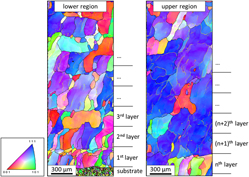Crossref Citations
This article has been cited by the following publications. This list is generated based on data provided by
Crossref.
Cao, Sainan
and
Gu, Dongdong
2015.
Laser metal deposition additive manufacturing of TiC/Inconel 625 nanocomposites: Relation of densification, microstructures and performance.
Journal of Materials Research,
Vol. 30,
Issue. 23,
p.
3616.
Michalcová, Alena
Palm, Martin
Senčeková, Lucia
Rolink, Gesa
Weisheit, Andreas
and
Kubatík, Tomas Frantisek
2015.
Microstructures of Iron Aluminides Processed by Additive Layer Manufacturing and Spark Plasma Sintering.
Manufacturing Technology,
Vol. 15,
Issue. 4,
p.
610.
Karczewski, Krzysztof
Stępniowski, Wojciech
Kaczor, Piotr
and
Jóźwiak, Stanisław
2015.
Fabrication of Fe-Al Intermetallic Foams via Organic Compounds Assisted Sintering.
Materials,
Vol. 8,
Issue. 5,
p.
2217.
Durejko, Tomasz
Ziętala, Michał
and
Bojar, Zbigniew
2015.
The Structure of FeAl Sinters Fabricated Using Cyclic Loading.
Materials,
Vol. 8,
Issue. 2,
p.
575.
Sun, Shaobo
Zheng, Lijing
Liu, Yingying
Liu, Jinhui
and
Zhang, Hu
2015.
Characterization of Al–Fe–V–Si heat-resistant aluminum alloy components fabricated by selective laser melting.
Journal of Materials Research,
Vol. 30,
Issue. 10,
p.
1661.
Yap, C. Y.
Chua, C. K.
Dong, Z. L.
Liu, Z. H.
Zhang, D. Q.
Loh, L. E.
and
Sing, S. L.
2015.
Review of selective laser melting: Materials and applications.
Applied Physics Reviews,
Vol. 2,
Issue. 4,
Martin, J.
Martinavicius, A.
Bruyère, S.
Van Landeghem, H.P.
Gendarme, C.
Danoix, F.
Danoix, R.
Redjaimia, A.
Grosdidier, T.
and
Czerwiec, T.
2016.
Multiscale analysis of an ODS FeAl40 intermetallic after plasma-assisted nitriding.
Journal of Alloys and Compounds,
Vol. 683,
Issue. ,
p.
418.
Durejko, Tomasz
Ziętala, Michał
Łazińska, Magda
Lipiński, Stanisław
Polkowski, Wojciech
Czujko, Tomasz
and
Varin, Robert A.
2016.
Structure and properties of the Fe3Al-type intermetallic alloy fabricated by laser engineered net shaping (LENS).
Materials Science and Engineering: A,
Vol. 650,
Issue. ,
p.
374.
Lotfian, Saeid
Rolink, Gesa
Weisheit, Andreas
and
Palm, Martin
2017.
Chemically graded Fe–Al/steel samples fabricated by laser metal deposition.
MRS Advances,
Vol. 2,
Issue. 26,
p.
1393.
Zhang, Bi
Li, Yongtao
and
Bai, Qian
2017.
Defect Formation Mechanisms
in Selective Laser Melting: A Review.
Chinese Journal of Mechanical Engineering,
Vol. 30,
Issue. 3,
p.
515.
Michalcová, Alena
Senčekova, Lucia
Rolink, Gesa
Weisheit, Andreas
Pešička, Josef
Stobik, Martin
and
Palm, Martin
2017.
Laser additive manufacturing of iron aluminides strengthened by ordering, borides or coherent Heusler phase.
Materials & Design,
Vol. 116,
Issue. ,
p.
481.
Karczewski, Krzysztof
Pęska, Magda
Ziętala, Michał
and
Polański, Marek
2017.
Fe-Al thin walls manufactured by Laser Engineered Net Shaping.
Journal of Alloys and Compounds,
Vol. 696,
Issue. ,
p.
1105.
Łazińska, M.
Durejko, T.
Zasada, D.
and
Bojar, Z.
2017.
Microstructure and mechanical properties of a Fe-28%Al-5%Cr-1%Nb-2%B alloy fabricated by Laser Engineered Net Shaping.
Materials Letters,
Vol. 196,
Issue. ,
p.
87.
Wang, Bin
Cui, Cheng-wu
Zhang, Sen-feng
and
Bai, Jiang-hu
2017.
Electrochemical corrosion behavior of Fe 3 Al in H 2 S-CO 2 -Cl − environment.
Materials Chemistry and Physics,
Vol. 198,
Issue. ,
p.
7.
Łazińska, Magdalena
Durejko, Tomasz
Czujko, Tomasz
and
Bojar, Zbigniew
2018.
The Effect of the Traverse Feed Rate on the Microstructure and Mechanical Properties of Laser Deposited Fe3Al (Zr,B) Intermetallic Alloy.
Materials,
Vol. 11,
Issue. 5,
p.
792.
Luis, Núria Cinca i
2018.
Intermetallic Compounds - Formation and Applications.
Hitzler, Leonhard
Merkel, Markus
Hall, Wayne
and
Öchsner, Andreas
2018.
A Review of Metal Fabricated with Laser‐ and Powder‐Bed Based Additive Manufacturing Techniques: Process, Nomenclature, Materials, Achievable Properties, and its Utilization in the Medical Sector.
Advanced Engineering Materials,
Vol. 20,
Issue. 5,
Harun, W.S.W.
Manam, N.S.
Kamariah, M.S.I.N.
Sharif, S.
Zulkifly, A.H.
Ahmad, I.
and
Miura, H.
2018.
A review of powdered additive manufacturing techniques for Ti-6al-4v biomedical applications.
Powder Technology,
Vol. 331,
Issue. ,
p.
74.
Le Dantec, Marie
Abdulstaar, Mustafa
Leistner, Matthias
Leparoux, Marc
and
Hoffmann, Patrik
2018.
Industrializing Additive Manufacturing - Proceedings of Additive Manufacturing in Products and Applications - AMPA2017.
p.
104.
Pan, Wei
Tang, Yangjie
Liu, Yantao
Zhang, Yongzhong
and
Wu, Pengyue
2018.
Advances in Materials Processing.
p.
543.
